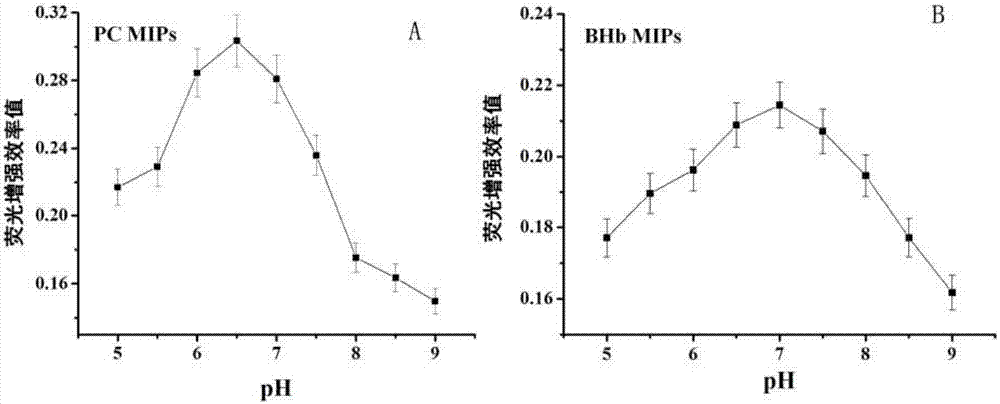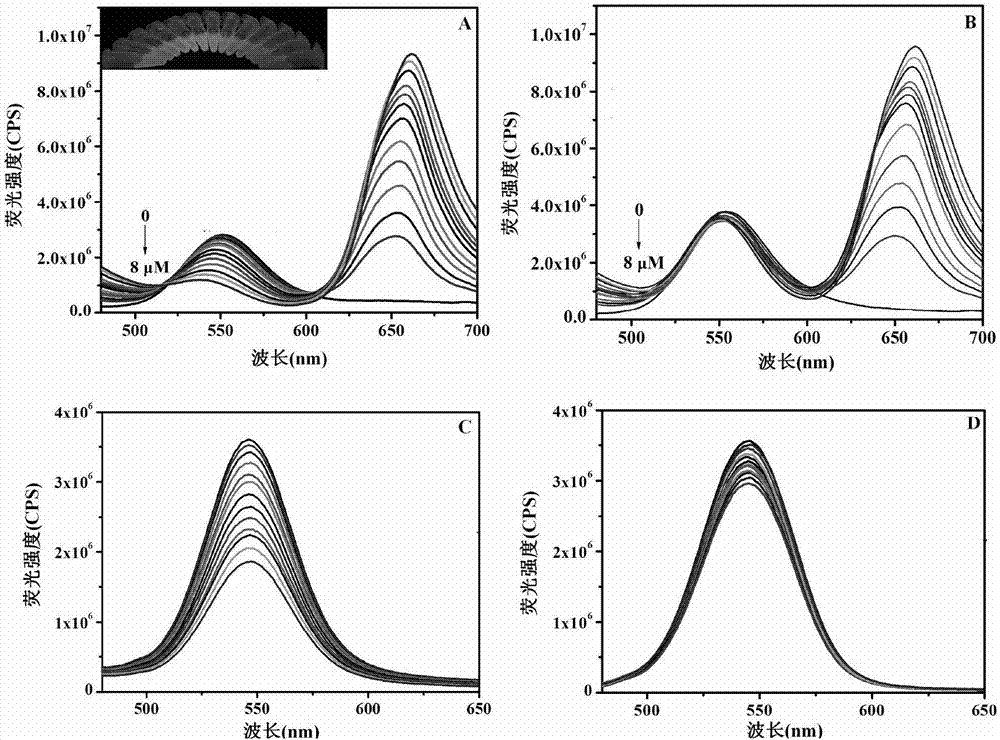Quantum dot-based protein imprinted polymer microsphere as well as preparation and application thereof
A Western blotting and polymer technology, applied in the fields of materials science and engineering and bioseparation engineering, can solve the problems of difficult to ensure quantum dots embedding, cumbersome modification process, difficult to control, etc., and achieve rich molecular imprinting/protein related research, high Identify selective, highly selective effects
- Summary
- Abstract
- Description
- Claims
- Application Information
AI Technical Summary
Problems solved by technology
Method used
Image
Examples
Embodiment 1
[0034] a. Preparation of CdTe quantum dots co-stabilized by thioglycolic acid and glutathione: Weigh 38.3mg of tellurium powder and 40mg of sodium borohydride, add 1.5mL of ethanol and 0.5mL of water to isolate the system from oxygen. Heat the reaction in a water bath until the black tellurium powder disappears completely and the supernatant turns lavender. Weigh 92.4 mg of cadmium nitrate and add it to 75 mL of water, then add 25 μL of thioglycolic acid and 110 mg of glutathione, adjust the pH to 9 with 1M sodium hydroxide solution, blow with nitrogen for 30 minutes, and then take the lavender supernatant prepared above Add 1mL of the liquid into the cadmium nitrate solution, under the protection of nitrogen, reflux for 2 hours, and obtain the CdTe quantum dot liquid co-stabilized by green thioglycolic acid and glutathione (TGA-GSH).
[0035] b. Preparation of phycocyanin imprinted polymer: Take 5 mL of TGA-GSH co-stabilized quantum dot solution prepared above, add it to 10 m...
Embodiment 2
[0038] Take 10 μL of the CdTe quantum dots, phycocyanin imprinted polymers (PC MIPs), non-imprinted polymers (PC NIPs) and bovine hemoglobin imprinted polymers (BHb MIPs) obtained by diluting 1000 times with ultrapure water respectively. and non-imprinted polymer (BHb NIPs) solutions, each dilution was dispersed on a copper grid washed with ethanol, after drying, the copper grid loaded with the above-mentioned diluted substances was observed with a transmission electron microscope (see figure 2 A-E); if figure 2 As shown in A, the particle size of quantum dots is about 2nm, such as figure 2 As shown in B, the particle size of PC MIPs is about 5nm, and the dispersion is very good. The thickness of the imprinted layer of phycocyanin is about 3nm. Such a thin imprinted layer is very beneficial for obtaining higher detection sensitivity and faster response of. Such as figure 2 As shown in C, the particle size and shape of PC NIPs are similar to those of quantum dots, indica...
Embodiment 3
[0040] After ultrasonically dispersing the prepared phycocyanin imprinted polymer (PC MIPs) solution, 3 parallel copies were taken, and 1 mL of PC MIPs solution was added to a weighed 1.5 mL centrifuge tube, dried and then weighed. By calculating the ratio of the mass difference before and after the three parallel samples to the volume, the average value is the concentration of the PC MIPs solution, and the concentration is 4.6 mg / mL.
[0041] During detection, 0.2 mL of the PC MIPs solution with a concentration of 4.6 mg / mL obtained above was taken, and the total volume of the measurement solution was 0.5 mL, that is, the concentration of PC MIPs was 1.84 mg / mL. In the same way, the concentration of bovine blood red fluorescent nanoimprinted polymers (BHb MIPs) in the detection process was 1 mg / mL.
[0042] Prepare a series of PBS buffer solutions with pH values of 6.0, 6.5, 7.0, 7.5, 8.0, 8.5 and 9.0. In the first group, take 0.2 mL of phycocyanin imprinted polymer (PC MI...
PUM
| Property | Measurement | Unit |
|---|---|---|
| thickness | aaaaa | aaaaa |
| particle diameter | aaaaa | aaaaa |
| particle diameter | aaaaa | aaaaa |
Abstract
Description
Claims
Application Information
 Login to View More
Login to View More - R&D
- Intellectual Property
- Life Sciences
- Materials
- Tech Scout
- Unparalleled Data Quality
- Higher Quality Content
- 60% Fewer Hallucinations
Browse by: Latest US Patents, China's latest patents, Technical Efficacy Thesaurus, Application Domain, Technology Topic, Popular Technical Reports.
© 2025 PatSnap. All rights reserved.Legal|Privacy policy|Modern Slavery Act Transparency Statement|Sitemap|About US| Contact US: help@patsnap.com



